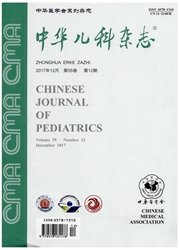

 中文摘要:
中文摘要:
目的探讨Toll样受体(TLRs)信号途径在川崎病(KD)免疫发病机制中的作用。方法急性期KD患儿16例,正常同年龄对照组16例。KD患儿分别于静脉丙种球蛋白(IVIG)治疗前后直接取血备检,未加任何体外丝裂原刺激培养。采用逆转录一聚合酶链反应(RT-PCR)及荧光定量PCR检测外周血单个核细胞TLRs1~10,MD-2,MyD88,IL-113,IL-6及IL-8 mRNA的表达;流式细胞术分别检测单核/巨噬细胞表面TLRs2、4及共刺激分子CD80、CD86的表达。结果(1)急性期KD患儿TLR4 mRNA及蛋白表达均显著高于正常同年龄对照组[Real-time PCR(325.22±50.34)W.(2.20±0.23),P〈0.01);流式细胞术检测(15.96±5.94)%W.(3.21±0.62)%,P〈0.01],其他TLR表达无明显改变;(2)TLR4传导途径相关因子MD-2及MyD88亦明显增高(P〈0.01),IVIG治疗后有不同程度下降;(3)急性期KD患儿组单核/巨噬细胞表面共刺激分子及前炎症细胞因子表达亦明显增高(P〈0.01)。结论急性期KD患儿TLR4及其相关分子MD-2、MyD88异常增高,提示TLR4异常活化可能是KD免疫功能紊乱的始动因素之一。
 英文摘要:
英文摘要:
Objective A great deal of clinical evidence and epidemiologic data suggest that Kawasaki disease (KD) is correlated with an acute regulating imbalance of immunology. Lots of evidences in the past suggested that nuclear transcription factor-KB and preinilammation factors were up-regulated significantly in patients with KD. But the causative factors are still unknown. Toll-like receptors (TLRs) is a type Ⅰ trans-membrane protein which could recognize ligands of pathogen microbes, activate the nuclear transcription factor-KB and promote gene transcription of pre-inilammation factors and co-stimulatory molecules on cell surface. Aberrant activation of signal pathway of TLRs could interfere with autoimmune tolerance and cause autoimmune diseases. The study was designed to investigate the role of signal transduction of TLRs on immunological pathogenesis of KD. Methods Sixteen children with KD and 16 age-matched health children were studied. Reverse-transcription PCR (RT-PCR) and real-time PCR were used to evaluate the levels of TLRs 1 - 10, MD-2, MyD88, IL-1β, IL-6 and IL-8 mRNA expressions in peripheral blood mononuclear cells, and expressions of TLRs 2, 4 and co-stimulatory molecules such as CD80 and CD86 in monocyte/macrophage were analyzed by flow cytometry. Results ( 1 ) Compared with control group, the protein and mRNA levels of TLR4 in KD group were up-regulated significantly [ ( Realtime PCR:325. 22 ±50. 34 vs. 2.20 ±0.23,P〈0.01);(flow cytometry: 15.96% ±5.94% vs. 3.21% ± 0. 62% ,P 〈0. 01 ) ] ,the difference being not significant as to other TLRs. (2) Transcriptional levels of MD- 2 and Myd88 were significantly up-regulated in acute phase of KD ( P 〈0. 01 ), and down-regulated after the treatment with intravenous gamma globulin therapy. (3) Expressions of co-stimulatory molecules and cytokines in monecyte/macrophage during acute phase of KD were higher than those of control group ( P 〈 0. 01). Conclusion Expressions of TLRs 4, MD-2 and Myd88 were up-reg
 同期刊论文项目
同期刊论文项目
 同项目期刊论文
同项目期刊论文
 期刊信息
期刊信息
